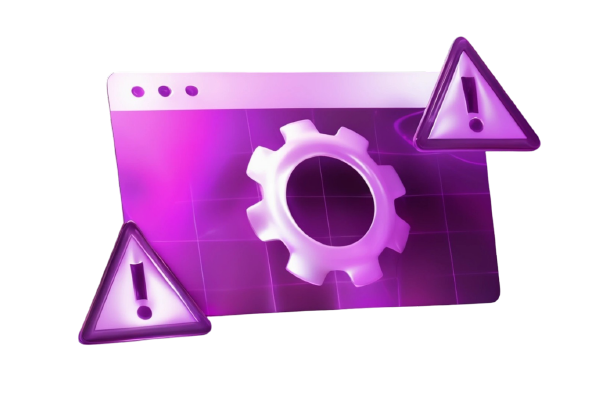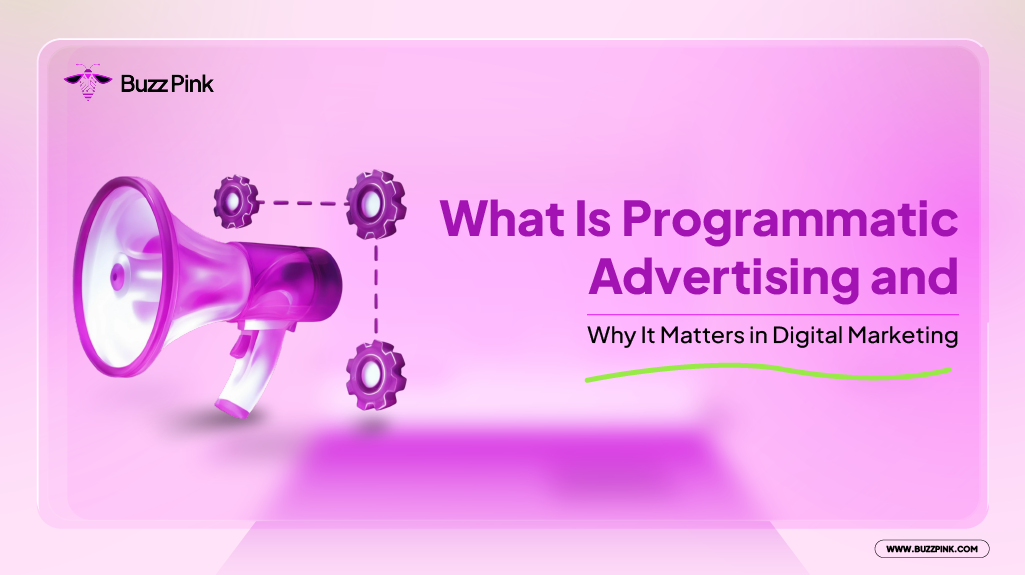Reaching out to each of the website’s contact persons in order to have your advertisement displayed is a waste of time. Today, thanks to advanced technology, programmatic advertising was invented, making everything easier.
At first glance, the term appears technical and confusing. However, it is simply an automated method of displaying a digital advertisement to a specific audience at specific times. That is one of the benefits of programmatic advertising, which is effective in reaching the desired audience with minimal effort.
What Is Programmatic Advertising?
Programmatic advertising is an automated procedure of making purchases and selling products by placing internet advertisements. The computer will determine when and where the advertisement will appear based on the user’s internet browsing habits. Nowadays, it is more commonly known as an internet algorithm.
For example, consider a friend’s upcoming birthday, and you know he’s been wanting a baseball cap. So you’ve spent the last two weeks browsing baseball caps. The more eagerly you look, the more baseball cap programmatic advertisements will appear. All because it has been learning from your habits over the last two weeks.
What Is Programmatic Media Buying?
It is a type of programmatic advertising, which refers to purchasing advertisement space on the internet, and because it is automated, the computer itself makes the purchase. No necessity to partner with a third party.
Read More: What Is Prompt Engineering? A Beginner’s Guide to Mastering AI Communication
This function ensures that the advertisement does not go to waste by keeping the ads targeted so that they are only shown to the intended audience. Furthermore, this system ensures that everything remains within budget. There will be no money burning or scams.
Why Does Programmatic Matter?
Programmatic advertising is crucial for maximizing your time, productivity, and financial resources. The process is automated and immediate, so you don’t need a large team to get it done.
Furthermore, the system is capable of learning the performance of advertisements. So, if your advertisements are ineffective, the system can provide feedback to help you improve your results.
Programmatic vs Display Ads
Display ads are the visual representations of advertisements, such as banners that appear on a website, whereas programmatic advertising is the method by which the advertisements appear. It implies that all programmatic ads are display ads, but not all display ads use programmatic.
Some display advertisements are still purchased and displayed manually. The key difference lies in the buying process, in which programmatic uses automation and data, while traditional display ads rely on manual placements and fixed deals.
The Advantages of Programmatic Advertising
 As previously stated, programmatic advertising has numerous benefits that many business owners value. It is efficient, focused, cost-effective, transparent, and scalable.
As previously stated, programmatic advertising has numerous benefits that many business owners value. It is efficient, focused, cost-effective, transparent, and scalable.
Efficiency
Traditional advertising involves a lengthy process, such as contacting the contact person, negotiating the price, and signing the contract. However, with programmatic, every aspect is much faster because it is finished instantly and in real time.
This means advertisers can launch campaigns much quicker and respond to market changes almost instantly. Instead of waiting days or weeks for setup, ads can be live within minutes. Moreover, adjustments like changing the target audience or updating the budget can be made on the fly. This level of agility makes marketing more adaptive and efficient than ever before.
Wide Reach
People can be reached through programmatic advertising based on their shopping habits, video watching, and browsing on multiple devices. This allows for more targeted advertising.
Not only that, but the technology also enables advertisers to follow a user’s journey across platforms. Whether someone is on their phone during a morning commute or watching videos on their tablet in the evening, programmatic makes it possible to serve relevant ads at every step. It’s like having a personalized ad assistant that understands where and when to show up.
Transparency
Previously, we had no way of knowing where our ads would appear. However, programmatic allows us to directly determine the location, type of website, and even the performance of the ad.
This helps brands avoid wasting money on placements that don’t align with their audience or values. Through detailed reports and dashboards, marketers can track which publishers bring the best return, spot suspicious traffic, and block sites that don’t meet their standards. Transparency leads to smarter decisions and better results.
Measurement
Real-time data can be provided through programmatic means. So we know how many people see, click, or purchase our advertisements. This allows us to improve our advertisements while the campaign is still running.
Instead of waiting until the campaign ends, advertisers can monitor results by the hour and tweak underperforming elements right away. For example, if a particular ad isn’t getting clicks, it can be swapped out immediately. This ongoing optimization helps maximize results and prevent budget waste.
The Challenges of Using Programmatic Advertising
 Regardless of its benefits, no system is ever perfect. Programmatic advertising does, however, present some challenges that should not be overlooked. This is something that business owners must consider as well.
Regardless of its benefits, no system is ever perfect. Programmatic advertising does, however, present some challenges that should not be overlooked. This is something that business owners must consider as well.
Commodification
Because almost every business now uses programmatic, advertisements are highly competitive, and ad space is becoming increasingly limited. However, there is a new invention called Programmatic Guaranteed, which provides you with secure ad space without requiring you to participate in an auction.
Still, this surge in advertisers competing for the same audience has led to something called “ad fatigue.” People are bombarded with similar messages across the web, and they’ve learned to ignore them. This makes it more important than ever to stand out with strong creatives, engaging storytelling, and personalized messages that actually speak to your target market.
Brand Transparency and Security
While programmatic advertising can give you more control, brand safety remains a concern. For example, it accidentally let your advertisements appear on inappropriate websites. Fortunately, there are numerous tools available now to assist in recovering this information.
Read More: SEO and SEM: What’s the Difference and Why It Matters
To further strengthen brand protection, companies can use tools like blacklists, whitelists, and AI-powered contextual targeting. Partnering with third-party verification services also helps ensure ads appear in safe environments. By combining automation with human oversight, brands can strike the right balance between efficiency and security.
Demand-Side Platform (DSP)
DSP software is designed for advertisers. Advertisers can use DSP to purchase ad space from multiple sources at the same time. They can select ad targets based on age, hobbies, purchasing habits, and so on. As a result, advertisements can be more effective and targeted.
This automation helps reduce manual work and gives advertisers access to a wider inventory of ad spaces through a single interface. DSPs also allow real-time bidding, so advertisers only pay for impressions that meet their targeting criteria, increasing both efficiency and ROI.
Supply-Side Platform (SSP)
SSP is software tailored for site or application owners. They use SSP to provide advertising inventory to a broad number of advertisers. SSP allows them to get the best price because many advertisers can participate in the ad auction on their site at the same time.
By using SSPs, publishers can maximize their revenue and maintain more control over the types of ads that appear on their sites. They can also apply filters to block inappropriate content and manage the user experience better, all while monetizing their platform efficiently.
Real-Time Bidding (RTB)
RTB is a real-time advertising auction process. So, when you visit a website, an ad auction begins shortly. Whoever places the highest bid will have their ad appear on that website right away. This is efficient and improves the relevance of advertisements.
Given that the bidding executes within milliseconds, users don’t encounter delays. The benefit for advertisers is that they only pay for ads shown to users who match their target profile, while publishers can make sure each impression earns its highest possible value.
Header Bidding
Header bidding is a technique in which a website solicits bids from multiple advertisers all at once before displaying the ad. That way, site owners can select the best offer, and advertisers have a better chance of receiving premium ad placement.
Compared to traditional methods where only one advertiser had access to bid first, header bidding levels the playing field. It increases competition, improves revenue for publishers, and gives advertisers access to better ad inventory that may have been previously unavailable.
Ad Exchange
Ad exchanges are online marketplaces where advertisers and site owners can connect. This is where the ad auction is conducted automatically. Advertisers can estimate how much their ads will cost and where they will be displayed, resulting in the process being more transparent and truthful.
These exchanges operate in real time and integrate with DSPs and SSPs to facilitate seamless transactions. With standardized formats and centralized access, ad exchanges make it easier for both sides to do business without needing direct one-on-one deals.
How Do Programmatic Ads Work?
First, decide what the campaign’s goal is. Do you want to introduce new products or aim to increase sales? Following that, select an advertisement format, such as image, video, or application ads. Next, determine the duration of the auction, the auction deadline, and the bidding strategy. Last but not least, use the performance reports to optimize the ads throughout the campaign.
Each step is supported by technology that handles targeting, bidding, and placement. Platforms collect real-time data and use it to constantly adjust the ad delivery. So, even during a live campaign, you can fine-tune based on what’s working best, whether that means shifting the audience or replacing underperforming creatives.
The Costs of Programmatic Advertising
 The rate is adjusted by the CPM, or the cost per thousand impressions of the advertisement. The cost is determined by the target audience, the duration of the advertisement, and the medium (the image is typically less expensive than the video). As the target audience becomes more refined and specific, the CPM will likely increase. Every aspect of this was achieved as part of the RTB process.
The rate is adjusted by the CPM, or the cost per thousand impressions of the advertisement. The cost is determined by the target audience, the duration of the advertisement, and the medium (the image is typically less expensive than the video). As the target audience becomes more refined and specific, the CPM will likely increase. Every aspect of this was achieved as part of the RTB process.
In addition, other pricing models like CPC (cost per click) or CPA (cost per acquisition) can also be used, depending on the campaign’s goal. While programmatic advertising may seem costlier upfront compared to traditional methods, it often delivers higher returns due to its precision and adaptability.
How to Measure the Success of an Ad
There are three primary methods: determining the number of impressions, clicks, and what people do after seeing the image. You can also measure it in terms of business objectives. Reflect on your mission: is the goal to increase brand awareness, sell products, or simply determine how many visitors are interested enough to stay on the page after clicking the ads?
To go deeper, you can analyze conversion rates, bounce rates, time spent on site, and even return on ad spend (ROAS). Using analytics tools, you can track user behavior beyond the ad click, helping you understand what actions lead to real business results and how to replicate them in future campaigns.
Types of Programmatic Advertising
There are several types of programmatic advertising, each with its own set of advantages based on your business style and objectives.
Open Marketplaces
This is the most common type of auction, in which all advertisers can participate. It is widely available through a demand-side platform (DSP), making it highly competitive. While this allows advertisers to reach a large number of people at different price points, it also increases the risk of ad fraud and gives advertisers less control over where their ads appear because inventory is sourced from a variety of sites.
Private Marketplaces
Closed auctions are usually held by invitation only and are reserved for premium sites. Both advertisers and publishers benefit from increased control and transparency in these marketplaces. Because only selected advertisers can participate, brands gain access to high-quality ad placements, which are frequently found on reputable news or entertainment websites. This setup is ideal for advertisers concerned about brand safety and visibility.
Preferred Deals
Advertisers and site owners reach special agreements without going through an auction. In this procedure, advertisers can acquire ad space at a fixed charge right before the inventory is auctioned off. It provides them with priority access, while publishers benefit from predictable revenue. It benefits both parties, especially when developing long-term relationships or testing new campaigns with trusted media partners.
Programmatic Guaranteed
Ad placement is guaranteed without going through an auction process. This is useful for advertisers who want to know how many impressions they will receive. This is the most direct programmatic approach. Advertisers and publishers agree on a fixed price and volume in advance, ensuring delivery without competition. It combines programmatic automation with the predictability of traditional ad buying, making it ideal for large-scale campaigns that require guaranteed exposure.
Conclusion
Programmatic advertising has revolutionized how businesses run digital campaigns. By automating the ad buying process, it saves time, improves targeting, and delivers measurable results. With tools like DSPs, SSPs, and real-time bidding, advertisers can reach the right audience quickly and efficiently.
Despite its advantages, programmatic still comes with challenges like ad fatigue and brand safety concerns. But with smart strategies and continuous optimization, it remains one of the most powerful tools for reaching goals, whether it’s brand awareness, engagement, or sales.
Kamila Putri is a content strategist and digital marketing expert who helps brands craft messages that resonate and drive results. With a strong foundation in SEO, brand voice, and data-driven strategy, she has produced content that performs, whether it's optimized web copy, lead-generating campaigns, or conversion-focused messaging. At Buzz Pink, she applies this expertise to help clients grow through smart, search-focused digital strategies that engage, inform, and convert.


